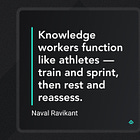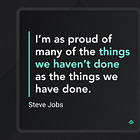How to Find Balance as a Maker and Manager
Improving your workflow with ideas from Paul Graham's seminal "Maker's Schedule versus the Manager's Schedule" concept.
Hello! I’m Pat and Better by Design is my newsletter sharing pragmatic insights for creative innovation through the lens of design. If you’re new here, join our growing tribe of design innovators!
If you caught my article “Why creatives should treat their work like athletic training”, you know I'm partial to the idea of intentionally designing your creative workflow. Doing great work isn’t about losing yourself to the grind; it's about finding the rhythm—the cyclical ebbs and flows between intense focus and necessary rest. Today, I want to hone in on a dilemma that many of us face in the pursuit of structuring our time for the highest creative output: the delicate dance between being the Maker and the Manager.
The maker and the manager: a delicate dance
Y Combinator founder Paul Graham has a seminal concept for consciously dividing your calendar—the Maker's Schedule versus the Manager's Schedule.
The Maker thrives on uninterrupted blocks of time, akin to an athlete in a training session. This deep work is where we create, innovate, and bring our most intricate ideas to life. For me, blocking off big chunks of time for creative work is critical for enabling the focus I need to do my best work. I usually try to do this in segments of 3-4 hours, similar to what Paul mentions in his essay.
But here's the rub: most of us don’t have the luxury of acting solely as Makers. Whether you’re bootstrapping a startup, freelancing, or juggling responsibilities as an employee, you're inevitably going to wear the Manager's hat too. Managers live and die by the calendar invite. Their world is a mosaic of 30-minute blocks, filled with team meetings, client calls, and interpersonal decision-making. This kind of operational collaboration is an important building block of a performant organization, but working in Manager mode requires a different energy and headspace than what you need while Making and it’s not always easy to make the shift.
The pitfall of the juggling act
Switching between these modes is where things get tricky.
As a Maker, you yearn for those delicious hours of solitude to sink into a design, untangle the nuances of a tricky piece of code, or write an insightful strategy. But as a Manager, you're pulled in different directions—your attention fragmenting with every Slack notification.
Sound familiar?
The impacts of the juggling act vary depending on your primary role but make no mistake, we all feel them.
As a Maker employee, you often don’t control and have minimal influence on the communication protocols of your organization. So if the systems aren’t set up to facilitate deep work it’s easy to feel scrambled.
For Managers, it’s often hard to find open moments long enough to feel like you can think rather than manage. It’s easy to end up doing your creative work outside normal work hours since that’s the main time you know others won’t try to reach you.
For entrepreneurs, the struggle of creating while being saddled with a million operational tasks can result in focus paralysis. I bump up against this almost every day while creating Better by Design.
But here’s the good news: while the tension and pendulum swings between modes are unavoidable, we can take action to minimize the shock of the switch and set ourselves up for improved performance in both states.
The key: conscious compartmentalization
So, what's the secret sauce? How do you master this tightrope walk between being a Maker and a Manager without falling flat on your face?
The answer lies in conscious compartmentalization.
Create distinct time blocks in your day and week for each role and stick to them like your life depends on it because, honestly, your creative life does.
In my world, mornings are sacred. I protect them at all costs and try to stay off the grid, diving into whatever needs my creative attention. I’m more flexible in the afternoons. Often that's when Manager Patrick comes alive, tackling operational tasks that need to be done, taking meetings, and just generally engaging with the world. I don’t only look at mornings and afternoons though, I also look at the structure of the week. As an introvert, I tend to have to hype myself up energetically to get the most out of my Manager mode so it’s helpful for me to constrain those activities to distinct days when possible. Even if those days leave me feeling extra drained, it’s worth the tradeoff as it allows me to perform better in that mode as well as when I shift back into Making the next day.
In the context of tech organizations, executives must actively design an environment that facilitates the best engagement of both modes. Employees in either Maker or Manager roles need the help of the organization to balance their primary role with the alternate. In my experience, companies are particularly prone to losing dedicated time for Making unless they actively protect it. The consequences can be subtle at first but snowball in severity. Not staying focused can lead to lower-quality output and slower delivery. This can, in turn, cause bigger problems like missing commitments or delivering subpar work. As a result, you might end up spending more time fixing less important issues instead of working on more valuable new projects. It's not a great state for any business. So be mindful to craft your company processes to protect these two distinct modes of work! Your employees and customers will thank you.
Final thoughts
To hit the mark in today's creative economy, mastering the art of switching between Maker and Manager roles isn't just a 'nice to have'; it's a 'must-have.' Your ability to balance these dual identities will define the trajectory of your creative endeavors, whether as an employee or entrepreneur.
So here's my challenge to you: this week, consciously designate time on your calendar to be a Maker or a Manager. Create a pact with yourself to honor these time blocks, and observe how the compartmentalization impacts your output and overall mental state.
The road to creative excellence is paved with many stones, but knowing when to be the Maker or the Manager? That's a keystone.
If you got a little value in this post, consider subscribing, sharing, or following me on Twitter. If you got a lot of value I’d appreciate it if you bought me a coffee 😎☕️.






